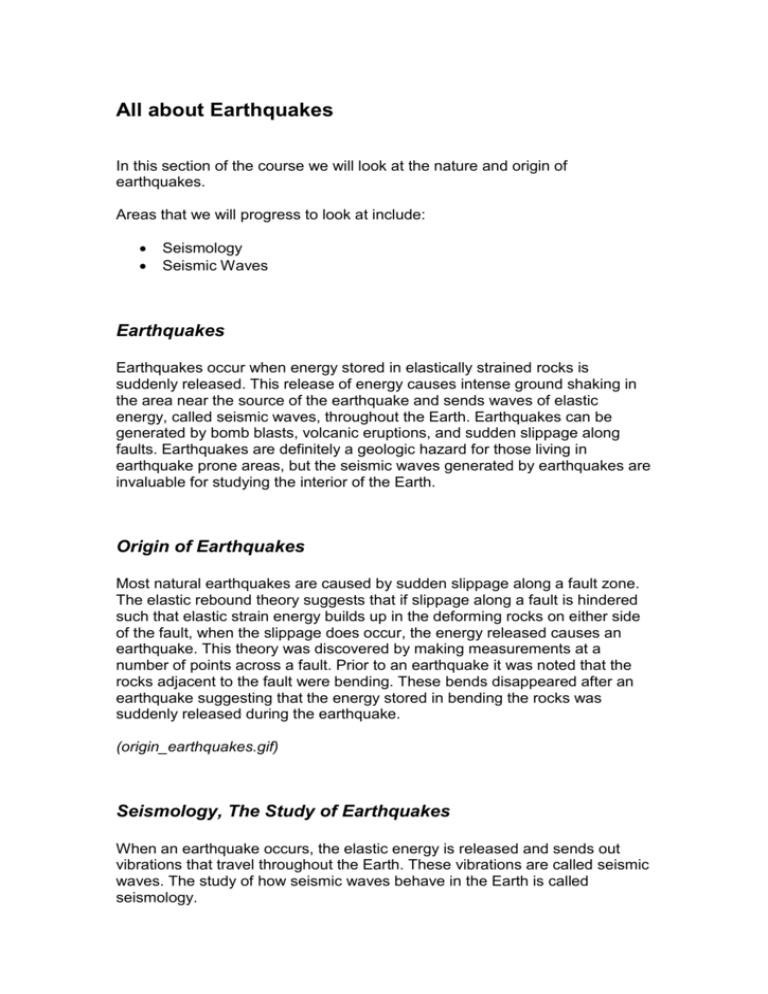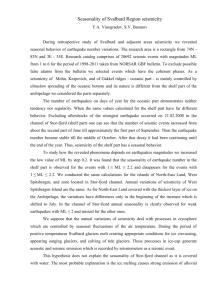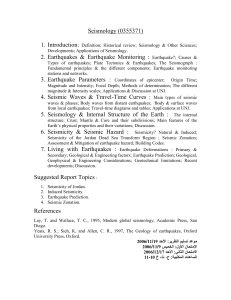Earthquakes
advertisement

All about Earthquakes In this section of the course we will look at the nature and origin of earthquakes. Areas that we will progress to look at include: Seismology Seismic Waves Earthquakes Earthquakes occur when energy stored in elastically strained rocks is suddenly released. This release of energy causes intense ground shaking in the area near the source of the earthquake and sends waves of elastic energy, called seismic waves, throughout the Earth. Earthquakes can be generated by bomb blasts, volcanic eruptions, and sudden slippage along faults. Earthquakes are definitely a geologic hazard for those living in earthquake prone areas, but the seismic waves generated by earthquakes are invaluable for studying the interior of the Earth. Origin of Earthquakes Most natural earthquakes are caused by sudden slippage along a fault zone. The elastic rebound theory suggests that if slippage along a fault is hindered such that elastic strain energy builds up in the deforming rocks on either side of the fault, when the slippage does occur, the energy released causes an earthquake. This theory was discovered by making measurements at a number of points across a fault. Prior to an earthquake it was noted that the rocks adjacent to the fault were bending. These bends disappeared after an earthquake suggesting that the energy stored in bending the rocks was suddenly released during the earthquake. (origin_earthquakes.gif) Seismology, The Study of Earthquakes When an earthquake occurs, the elastic energy is released and sends out vibrations that travel throughout the Earth. These vibrations are called seismic waves. The study of how seismic waves behave in the Earth is called seismology. Seismographs - Seismic waves travel through the Earth as vibrations. A seismometer is an instrument used to record these vibrations and the resulting graph that shows the vibrations is called a seismograph. The seismometer must be able to move with the vibrations, yet part of it must remain nearly stationary. This is accomplished by isolating the recording device (like a pen) from the rest of the Earth using the principal of inertia. For example, if the pen is attached to a large mass suspended by a spring, the spring and the large mass move less than the paper which is attached to the Earth, and on which the record of the vibrations is made. Seismic Waves - The source of an earthquake is called the focus, which is an exact location within the Earth were seismic waves are generated by sudden release of stored elastic energy. The epicenter is the point on the surface of the Earth directly above the focus. Sometimes the media get these two terms confused. Seismic waves emanating from the focus can travel in several ways, and thus there are several different kinds of seismic waves. (seismograph.gif) Types of Seismic Waves Body Waves - emanate from the focus and travel in all directions through the body of the Earth. (seismicwaves.gif) Surface Waves - Surface waves differ from body waves in that they do not travel through the Earth, but instead travel along paths nearly parallel to the surface of the Earth. Surface waves behave like S-waves in that they cause up and down and side to side movement as they pass, but they travel slower than S-waves and do not travel through the body of the Earth. The record of an earthquake, a seismograph, as recorded by a seismometer, will be a plot of vibrations versus time. On the seismograph, time is marked at regular intervals, so that we can determine the time of arrival of the first Pwave and the time of arrival of the first S-wave. Because P-waves have a higher velocity than S-waves, the P-waves arrive at the seismographic station before the S-waves. All about Glaciers In this section of the course we will look at the nature and origin of Glaciers. Areas that we will progress to look at include: Glacier Speeds Glacial Ice Glacier Size Glaciers Glaciers constitute much of the Earth that makes up the cryosphere, the part of the Earth that remains below the freezing point of water. Most glacial ice today is found in the polar regions, above the Arctic and Antarctic Circles. While glaciers are of relatively minor importance today, evidence exists that the Earth's climate has undergone fluctuations in the past, and that the amount of the Earth's surface covered by glaciers has been much larger in the past than in the present. In fact, much of the topography in the northern part of North America, as well as in the high mountain regions of the west, owe their form to erosional and depositional processes of glaciers. The latest glaciation ended only 10,000 years ago. Definition of a glacier A glacier is a permanent (on a human time scale, because nothing on the Earth is really permanent) body of ice, consisting largely of recrystallized snow, that shows evidence of downslope or outward movement due to the pull of gravity. Types of Glaciers Mountain Glaciers - Relatively small glaciers which occur at higher elevations in mountainous regions. Smallest of these occupy hollows or bowl-shaped depressions on sides of mountains (cirque glaciers). Ice Sheets: (Continental glaciers): are the largest types of glaciers on Earth. They cover large areas of the land surface, including mountain areas. Modern ice sheets cover Greenland and Antarctica. Ice Shelves: Ice shelves are sheets of ice floating on water and attached to land. They usually occupy coastal embayments, may extend hundreds of km from land and reach thicknesses of 1000 m. Glaciers can also be classified by their internal temperature. Temperate glaciers - Ice in a temperate glacier is at a temperature near its melting point. Polar glaciers - Ice in a polar glacier always maintains a temperature well below its melting point Glacier Speeds Temperature Very cold Pretty cold Cold Chilly Mountain Glaciers 1.5mph 1.7mph 1.8mph 1.9mph Ice Sheets Ice Shelves 2.0mph 2.1mph 2.5mph 3.2mph 2.3mph 2.4mph 2.5mph 2.7mph Which glacier type moves fastest in very cold conditions? Answer = ice shelves The Mountain Glacier moves faster than an Ice Sheet in chilly conditions, true or false? Answer = False The Formation of Glacial Ice Glaciers can only form at latitudes or elevations above the snowline, which is the elevation above which snow can form and remain present year round. The snowline, at present, lies at sea level in polar latitudes and rises up to 6000 m in tropical areas. Glaciers form in these areas if the snow becomes compacted, forcing out the air between the snowflakes. As compaction occurs, the weight of the overlying snow causes the snow to recrystallize and increase its grain-size, until it increases its density and becomes a solid block of ice. Changes in Glacier Size A glacier can change its size by Accumulation, which occurs by addition of snowfall, compaction and recrystallization, and Ablation, the loss of mass resulting from melting, usually at lower altitude, where temperatures may rise above freezing point in summer. Thus, depending on the balance between accumulation and ablation during a full season, the glacier can grow or shrink Additional Glacier Resources Link to additional Glacier resources http://www.google.com/search?sourceid=navclient&ie=UTF-8&oe=UTF8&q=glaciers Flash Animation of an Earthquake Evolution of expected seismicity rate at Landers 1975-2010 When an earthquake occurs on a fault, the seismicity in the area surrounding the fault failure is modified. In some places it is promoted and in others it is inhibited. This effect tends to disappear with time but is also further modified when subsequent earthquakes occur. Since 1975, in the Mojave desert (Southern California), four consecutive earthquakes increased the expected seismicity rate at the location of the future Landers rupture. Consequently, three hours and 26 minutes after Landers, the Big Bear fault failed in the area of highest predicted seismicity. And again seven years later, the Hector Mine earthquake occurred in an area where the predicted seismicity rate was increased. The seismicity rate change, as derived from the stress change pattern through Dieterich's state/rate friction law (JGR, 1994), appears to be an appropriate descriptor of the seismicity affecting an area. This animation was presented by Ross Stein at the American Geophysical Union lecture 'Frontiers of Geophysics' in December 2001. Animations by Ross Stein and Keith Richards-Dinger. (insert seismicity_animation.swf) This animation downloaded from http://quake.wr.usgs.gov/research/deformation/modeling/animations/








